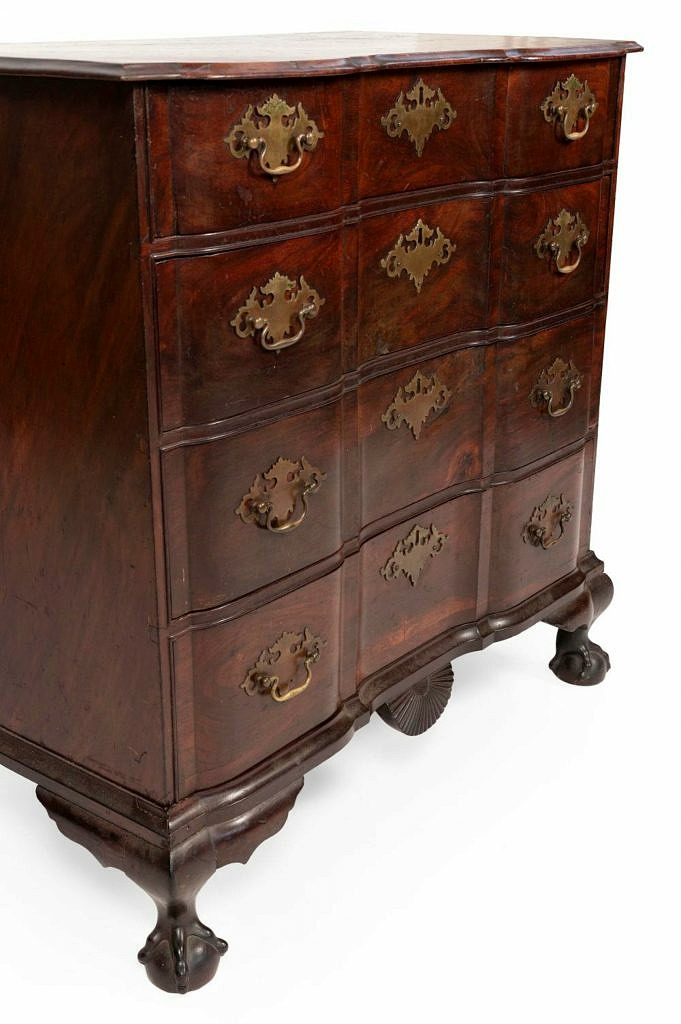Step 52 After you have cleared out all the trash, use a small plane or a sandpaper to smoothen the lines.
Step 53 The next step is to get rid of the excess at the corners. You can cut a majority out with the band saw, but I found that using carving chisels was a snap. The #7/20 sweep saw fits perfectly into the cut.
Step After that, place the Divider pattern 3/10cm behind the front edge for the Drawer Fronts. Then trace the pattern onto top of the Fronts.
Step 55 Make a separate pattern for the inside radius at both ends of the center recessed area. The radius is 1-
Step 56 Make a two step cut that will establish the squared or blocked area at the ends of your Drawer Fronts. The second cut will be with the tenon cutter jig as shown. Set the cut using the 3/10 cm mark.
Step 57 Now it is off to the band saw! I used the following:
Step 58 Shape the rounded fronts. To do the bulk of the work I used a Shinto raspberry, and then I went on to use finer rasps until I was ready for sanding. The back of the Fronts must also be smoothened.
Step 59 Pay close attention to the lines of the blocks. They need to be kept straight when working the Fronts. The Front can be shaped using a sharp chisel or straight edge, as well as a small square and a knife. Also, periodically position the Front into the Case and check the reveal around the opening to insure an accurate fit.
Step Make the Drawer Boxes. Bonnet Top High Chest Steps # 70-777. To receive the Drawer Bottom, cut the grove as in Desk and Bookcase Step #85.
Step Cut the Drawer Bottoms to the right size. Then, place the Drawer Boxes so that the inside front edge is parallel with the Bottom’s. Mark the profile of the drawer Front onto the Drawer Bottom.
Step HTML62 Make a profile and then run the bevel along the Drawer Bottom’s bottom. I used a shaper but you can also use a router table’s raised panel bit. Because the Bottom is 5/20 cm in thickness, the raised panel profile will leave a radius edge that needs to be clean off for the look of a beveled drawer bottom. Smoothen the profile with a plane, chisel and sander
Step HTML3_ 63 After you have trimmed the edges, don’t bevel the bottom edge. The panel will slide into your drawer box. After fitting the panel, check for fit and make any adjustments. Finally, draw a line along the inner edge to mark the Drawer Back. That line will establish the height of the blade to make the cut for the nails that hold the Bottom in position. Make a pass about 25 cm in from each end of the Bottom and attach to the Drawer Back with nails after the entire box and Bottom are sanded. Add a little glue to the groove at the front. Bonnet Top High Chest Step 85.
Step 64 Position the Drawers into the case and align the fronts so that the reveals are set, then use glue and brads to set the Drawer Stops as shown.
Step 65 Now you can start the finishing process. Make the backboards before you begin to finish the chest. They run horizontally across the back and are half-lapped at the joint. See Chest on Chest Step #61
Step 66 The Brass Pulls for this project need to be shaped to fit the curve of the rounded Drawer Fronts. Lay the pull on a scrap that is cut to the same profile and gently shape the Pulls. When the Chest is finished, the hardware can be installed.
Product Recommendations
These are the tools and supplies we use every day in our shop. We may receive a commission from sales referred by our links; however, we have carefully selected these products for their usefulness and quality.



